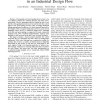Free Online Productivity Tools
i2Speak
i2Symbol
i2OCR
iTex2Img
iWeb2Print
iWeb2Shot
i2Type
iPdf2Split
iPdf2Merge
i2Bopomofo
i2Arabic
i2Style
i2Image
i2PDF
iLatex2Rtf
Sci2ools
DATE
2009
IEEE
2009
IEEE
Enabling concurrent clock and power gating in an industrial design flow
— Clock-gating and power-gating have proven to be very effective solutions for reducing dynamic and static power, respectively. The two techniques may be coupled in such a way that the clock-gating information can be used to drive the control signal of the power-gating circuitry, thus providing additional leakage minimization conditions w.r.t. those manually inserted by the designer. This conceptual integration, however, poses several challenges when moved to industrial design flows. Although both clock and power-gating are supported by most commercial synthesis tools, their combined implementation requires some flexibility in the back-end tools that is not currently available. This paper presents a layout-oriented synthesis flow which integrates the two techniques and that relies on leading-edge, commercial EDA tools. Starting from a gated-clock netlist, we partition the circuit in a number of clusters that are implicitly determined by the groups of cells that are clock-gated by ...
Additional Leakage Minimization | Commercial Synthesis Tools | DATE 2009 | Hardware | Industrial Design |
| Added | 20 May 2010 |
| Updated | 20 May 2010 |
| Type | Conference |
| Year | 2009 |
| Where | DATE |
| Authors | Leticia Maria Veiras Bolzani, Andrea Calimera, Alberto Macii, Enrico Macii, Massimo Poncino |
Comments (0)

